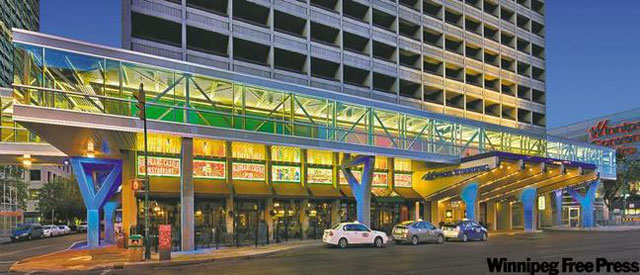
In 1820, Paris established itself as the 'City of Light' when it became one of the first in the world to illuminate its streets with gas lanterns. This transformed the character, economy and culture of the city as it came alive at night with shops and cafés remaining open long after dark. The soft orange light cast on the limestone buildings was considered so beautiful it inspired the works of impressionist painters like Renoir and Van Gogh.
Over the next two centuries, urban lighting across the world has most often been considered from a purely functional perspective, flooding streets and buildings with consistent, high-intensity light. With the emergence of new technologies, exterior lighting is again becoming an inspiring urban feature and creative extension of architectural design. Good architecture transforms itself as light conditions change around it. A unique example of this is the Buhler Centre on Portage Avenue by DPA+PSA+DIN Collective, which creatively uses metal tabs as nighttime reflectors, subtly animating the façade as they capture the moving light of passing cars.
This choreography of light and shadow is becoming a renewed trend in modern architecture. With the emergence of LED (light-emitting diode) technology, creative lighting opportunities are almost limitless. These ultra-efficient, extremely long-lasting fixtures allow designers to manipulate the colour and intensity of light cast on and from buildings at night.
Exterior lighting design can be an affordable way for building owners to add value to their properties by improving energy efficiency and enhancing the overall appearance and public perception of their buildings.
The new skywalk on St. Mary Avenue, by Number Ten Architectural Group, uses this technology to cost-effectively transform a typically utilitarian piece of urban infrastructure into a dramatic part of the neighbourhood. Y-shaped columns are lit with colour-changing LED lights that enliven the sidewalk at night, making the surrounding buildings more attractive and redefining the overall mood of the street. A number of cities are expanding on this idea by developing cohesive strategies for employing urban lighting as a tool for downtown revitalization. Modern lighting design has the potential to redefine public spaces at night. These techniques can alter the perception of downtown after dark, increasing pedestrian and commercial activity while decreasing energy use and light pollution.
In Montreal, a grand-scale lighting plan has been implemented that has transformed the city. As the sun sets, Old Montreal awakes with a new identity and a renewed vibrancy. Historic buildings shine like precious stones, their doorways illuminated in crisp white light, their copper domes highlighted in green. Buildings once lit only with the flat yellow light of overhead street lamps are today showcased in a composition of colour that brings their façades to life.
In 2007, the Downtown BIZ commissioned a similar master plan for Winnipeg by renowned Quebec lighting designers Éclairage Public, focusing on the illumination of Portage Avenue. Since then, the plan has been filed away with minimal implementation of its ideas and recommendations.
With several new developments proposed or under construction on Portage Avenue, the conditions are right to resurrect this master plan and begin implementing a cohesive lighting strategy that reclaims some of the past glory of Winnipeg's most famous strip.
A proposed 'Entertainment Zone' across from the MTS Centre will provide opportunities for theatrical lighting that contrasts the elegance of the old terra cotta sisters, the Boyd, Lindsay and Paris buildings, highlighting the eclectic mix of architecture along Portage Avenue. The Paris Building and the Radisson Hotel already have dramatic exterior lighting that highlights the texture, materials and layers of their façades. With refurbishment, they could become striking contributors to the overall scheme. Redevelopment of the Bay, the Avenue Building and the APTN studios provides further opportunity to rebrand Winnipeg's nighttime image.
In the Christmas season, thousands of Winnipeggers flock to various areas of the city to marvel at festive displays. A unified lighting strategy could redefine the nocturnal mood of our city, generating that same appeal year-round. Successful architectural lighting can attract people to the city centre after dark, improving the public image of downtown and acting as an effective tool in the battle against the greatest enemy of urban revitalization -- the perception of crime and lack of personal safety.
As lighting technologies continue to evolve, the opportunity is emerging to rediscover Winnipeg's evening cityscape in affordable and energy-efficient ways. By dusting off that lost master plan, Winnipeg's downtown may one day be a jewel case of sparkling buildings that transforms the depressing winter darkness of our northern city into an uplifting and nightly architectural celebration.
Brent Bellamy is senior design architect for Number Ten Architectural Group. Email him at Bbellamy@numberten.com
Republished from the Winnipeg Free Press print edition September 27, 2010 B5